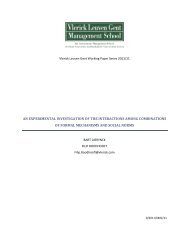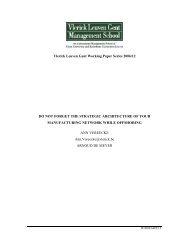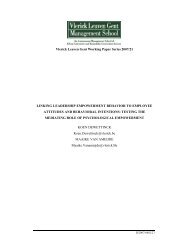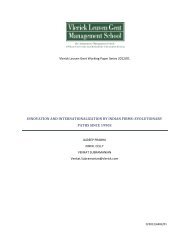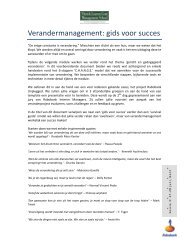Vlerick Leuven Gent Working Paper Series 2007/03 ... - Vlerick Public
Vlerick Leuven Gent Working Paper Series 2007/03 ... - Vlerick Public
Vlerick Leuven Gent Working Paper Series 2007/03 ... - Vlerick Public
You also want an ePaper? Increase the reach of your titles
YUMPU automatically turns print PDFs into web optimized ePapers that Google loves.
At the same time, based on socio-psychological research, greater heterogeneity on<br />
boards likely has a negative impact on cohesiveness. An explanation can be found in the<br />
social categorization and similarity/attraction theory. The first refers to the process of selfcategorization.<br />
The basic assumption of the social categorization theory is that individuals<br />
seek a positive self-identity. Therefore, on the base of demographic attributes, individuals<br />
classify themselves and others into social categories. This process permits the individual to<br />
define himself in terms of a social identity and to compare himself to others (Tajfel, 1982).<br />
Individuals are perceived as in-group members if they have similar features and out-group<br />
members otherwise. There is a tendency then to evaluate the members of other categories<br />
more negatively which results in stereotyping, polarization and anxiety (Tsui et. al., 1992).<br />
According to this theory, individuals tend to prefer homogeneous groups of similar persons.<br />
Diversity, in contrast will trigger the process of social categorization. The more diverse a<br />
board is composed, the greater the chance directors will be confronted with individuals of<br />
other social categories, resulting in increased hostility which may have detrimental effects on<br />
the cohesiveness within the board. A similar prediction is grounded in the similarity/attraction<br />
paradigm. According to this perspective, individuals who perceive themselves similar to<br />
others tend to empathize with and feel attracted to these other persons (Byrne, 1971).<br />
Similarity can appear on all kinds of attributes ranging from demographic variables to<br />
attitudes and values. Being similar reinforces a person’s attitude and beliefs while<br />
dissimilarity is considered negatively (Tsui and O’Reilly, 1989). Empirical research on groups<br />
already supports these predictions. In particular, diversity on attributes like gender, race and<br />
functional background have been found to negatively influence affective outcomes such as<br />
commitment, cohesiveness (or social integration), satisfaction etc. at both the individual and<br />
group level (see Milliken and Martins, 1996 and Williams and O’Reilly, 1998 for a review).<br />
Applied to a board context, diversity, irrespective of the way it is uttered/expressed, yields<br />
dissimilarity among the members which lowers interpersonal attraction and liking. Thus, we<br />
advance the following propositions :<br />
Proposition 3 a : the effect of board diversity on debate will be positive but when<br />
the board becomes too diverse, the impact on debate will be negative<br />
Proposition 3b : the greater the diversity in the board of directors, the less<br />
cohesiveness the board members will experience<br />
20



